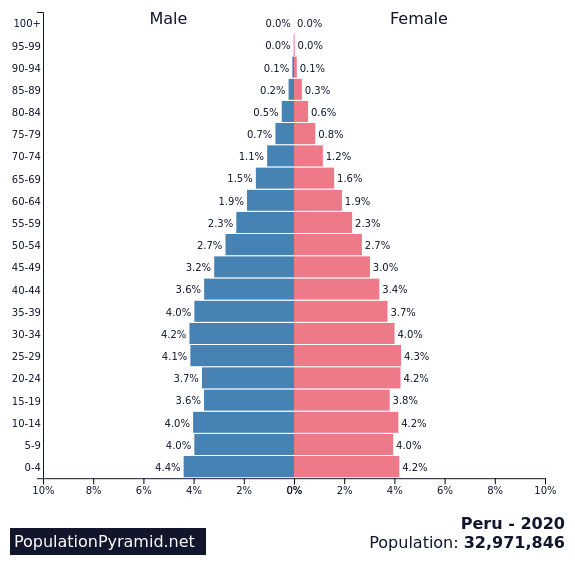Peru
A few indicators to better understand the situation
In a nutshell
Peru is the 20th largest country in the world -about the size of Alaska- located on the west coast of South America. It borders Bolivia, Brazil and Chile to the east and south, and Colombia and Ecuador to the north. The country is divided into three distinct geographical regions: a narrow, desert-like coast, the steep Andes Mountains that run north to south and the Amazon rainforest. Because of its particular geography, Peru contains 84 of 104 known ecosystems and 28 of 32 known climate zones, making it one of the most ecologically diverse nations in the world, according to the United Nations Development Program.
Peru will have a population of about 32 million by 2021 and is growing by about 1.5 percent annually, both organically and through a large influx from Venezuela. The Peruvian population is young: one-fourth of the inhabitants are under 15 years old, about half are under 30, only 12% of the population is over 60. 58% Of the population lives along the coast, 28% in the highlands and 14% in the jungle region. Lima, the capital, has about 11 million inhabitants, and is, after Sao Paolo in Brazil, the largest economic and financial pole in South America.

Recent political history has been marked by decades of struggle by the Maoist rebel movement Shining Path, considered the bloodiest movement in Latin America, against the Peruvian government. This “dirty war” took the lives of 70,000 people during the 1980s and 1990s, more than during the military dictatorship in Argentina and Pinochet’s regime in Chile combined. Peasants who refused to cooperate with the rebels were simply murdered. It is estimated that a few hundred adherents remain, hiding in remote areas and mainly engaged in drug trafficking. Currently, Peru is once again in politically turbulent waters. Deep-seated corruption has gripped the country for years. Three former presidents of Peru have spent time in prison over an ongoing bribery investigation. Another committed suicide in 2020 to evade arrest and yet another is in prison after multiple convictions for human rights violations, embezzlement of public funds and abuse of power. The country has seen 3 different presidents in barely 7 days in 2020.
Better...
The general health of the average Peruvian has improved well in recent decades. Life expectancy has increased, from 66 years in 1990 to 77 years in 2021, and infant mortality among children under five has fallen from 8% to 1.4% over the same period. One in three children in this age group suffers from anemia (this was still more than half in 1990). Just over 6% of the population is malnourished (among children under 5, this is still 1 in 8). In contrast, only 1 Peruvian in 10 is protected by some form of social security (among the poorest 20%, it is 1 in 100), so the slightest setback can easily send a family into a precarious situation.
Education levels have also risen sharply over the past 50 years. For example, in 2018, nearly 60% of the population over the age of 25 have completed their secondary studies (up from a good 10% in the early 1970s). Almost all children attend school on a more or less regular basis and the adult literacy rate is around 94%.
Over the past two decades, Peru has become one of the fastest growing economies in Latin America and there have been significant improvements in the well-being of children and their families. The government has made major investments in infrastructure, and access to basic services has greatly improved. 95% of the population now has access to electricity, 50% to potable water. Poverty was reduced by more than half and extreme poverty by as much as 75 percent. In 2017, just under 3% were living on less than US$1.90 a day. As a result of all this, Peru has recently ceased to be considered a developing country.
But...
Although poverty rates have fallen significantly, inequality between different population groups and geographic areas remains very high. Poverty is concentrated in poor, indigenous rural communities and slums, and the services to which they have access are of lower quality than those in urban areas. The poorest 10% of the population in Peru accounted for 1.70% of total income in 2017, while the richest 10% received 32.30%. The top 20% of Peru’s population owns more than half of the wealth, the bottom 60% only just over a quarter.
Unemployment is fairly low in Peru (about 6.5% before the sanitary crisis), but this gives a distorted picture of the labor market because three in five workers work in the informal, unofficial economy. For workers without a high school education and workers in rural areas, this is as high as 95% and 92%. Economists say this is mainly due to rigid labor laws. The World Economic Forum’s Global Competitiveness Report ranked Peru 133rd out of 140 countries in terms of companies’ ability to hire and fire workers. Although the organization praised Peru for employers’ flexibility in setting wages, hiring and firing practices and the tax regime make it difficult to hire workers. Jobs in the informal sector are precarious and there is no social safety net to fall back on in case of dismissal. In addition, it is difficult for official companies to compete with these unregistered companies which further complicates job creation. Corruption is an additional problem in Peru. Nearly one in five companies reported having faced forms of bribery at official agencies in 2017.
Finally, child labor is common in Peru, especially among the poorest layer of the population. According to official statistics, nearly 15% of children aged 6 to 17 receive some form of compensation. This puts Peru in third place in Latin America, after Nicaragua and Haiti. In reality, these figures are quite a bit higher and in many cases work (domestic or paid) competes with schooling, which threatens to further marginalize children from the poorest families.
And now?
Although Peru has taken a giant leap forward in the last two decades, economic growth has been slowing since 2014. According to a 2018 OXFAM report on rising poverty and inequality, both poverty rates and levels of inequality have risen again in recent years, a trend reversal from the previous 15 years. According to the National Institute of Statistics (INEI), 6.6 million Peruvians, or just over 20 percent of the population, were experiencing poverty at the end of 2019. Another 3.3 million people were added as a result of the COVID-19 pandemic, and another 11 million are in a precarious situation, with incomes only marginally above the national poverty line. This means that more than half of Peru’s population is currently living in poverty or at risk of falling below the poverty line. In rural areas, this is even close to 90%.
Peru’s current situation is far from rosy: 2020 was marked by COVID-19, increasing poverty and corruption, crumbling infrastructure, and three presidents in seven days.
